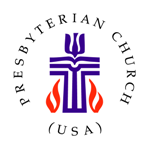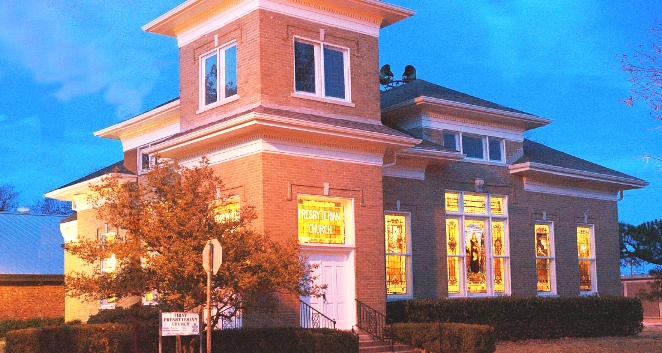Welcome to the First Presbyterian Church of Commerce
Our Stained Glass WindowsWithout a doubt, the most distinctive architectural feature of the sanctuary is the series of fourteen stained glass windows that surround the four external walls of the building. The orgininal windows were installed in late 1913 and 1914--shortly after the current building's dedication service on Oct. 19, 1913. (Note: there are two additional stained glass Through comparison with other stained glass windows in northeast Texas, we believe that the windows were made by the Kansas City Stained Glass Works Company at Kansas City, Missouri – one of the finest stained glass window companies in the country at the turn of the twentieth century. In preparing this update, we came across two references in session minutes that referred to contact with the very reputable Jacoby Art Glass Company of St. Louis, Missouri. Consequently, while fairly confident the windows came from the Kansas City Glass Works, we are not completely sure. Two things we are certain of, regardless of the manufacturer, are that the windows were not installed until after the dedication (late 1913 and early 1914) and that the windows would have been shipped by rail. While the windows are generally referred to as “stained glass,” they are not like the stained glass windows found in large churches in the East and Europe. Our windows are, in reality, “art glass” windows. This uniquely American form of art was developed in the United States in the late 19th and early 20th centuries. While large portions of the art glass windows are traditional stained glass put together with lead or “cane,” they also include paintings or pictures of religious scenes or symbols. On large windows the most common scenes depict events in the life of Christ. The pictures were painted by studio artists, using colored glazes, on clear glass which was then kiln fired to bring out the colors and to fuse the glaze to the glass. The art glass artists took great pride in faithfully reproducing works of well known European artists since at that time there was no such thing as international copyright protection. In fact, many artists were flattered that other artists and publishers would copy their paintings. Two of the most copied artists of the early 20th century were German painters, Heinrich Hoffman, 1824 – 1911, and Bernhard Plockhorst, 1825 – 1907. Copies of their works appeared in Bibles, Bible story books, Sunday school materials and church windows. Of the seven “art glass” windows found at First Church, Commerce, two are based on works by Hoffman: Christ in the Temple; and Christ in Gethsemane. Five are the works of Plockhorst: The Annunciation to the Shepherds; A Certain Samaritan; The Good Shepherd; Jesus Blessing the Children; and I Stand at the Door. Other small paintings include doves, boats, a Bible and a crown. Many of the windows are memorials to early church members; Nancy Maloney, 1813 – 1891; Henry C. Barker; Reverend Alfred Whitefield Wilson, D.D., 1833 – 1912; Reverend J. C. Grow, 1841 – 1903, the founding pastor; James R. Carmack, charter elder, Thomas Shields and family; Knox Craig, 1858 – 1906; Robert Morgan Scaff; Charles William Rush and Charles Forrest Rush; and Grandma Conder. Other windows were gifts of the Ladies Aid and Missionary Society and various Sunday school classes. These windows truly are a church treasure. | Image Gallery |

